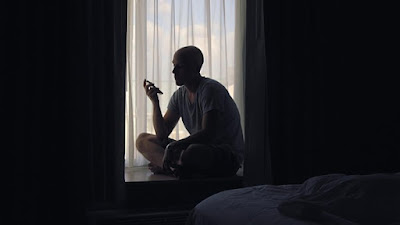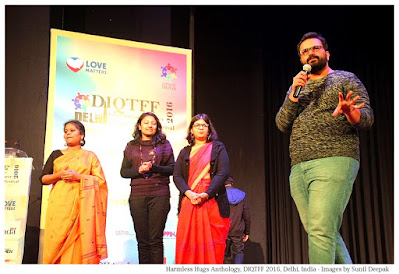I came across the story of Lila Lakshmanan Biro by chance. Half-Indian and half French, she has worked as a film-editor with many of the famous French film-directors like Godard and Truffaut in the 1960s.
Born in 1935, Lila will be ninety years old this year. She lives in an old age home in a suburb near Paris. My artist friend Samit Das, whom I have found on the journey to find Lila, has confirmed to me that she is fine and keeping well.
I first met Lila in a book when she was called Lila Herman. Finding her reincarnations into other names was an exciting search. This is the story of that journey.
My First Encounter With Lila
I came across her first when she was known as Lila Herman, while doing research about the Roberto Rossellini - Sonali Dasgupta story.
In December 1956, Roberto, well-known Italian director, famous for his neo-realistic films like Rome, Open City and Paisà, came to India to shoot a film. Sonali Dasgupta, wife of Indian producer-director Harisadhan Dasgupta, was supposed to collaborate with Roberto. The two fell in love and this created a huge scandal in India. Hounded by journalists and an upset family, Sonali looked for support. She found some support in Lila Herman.
At that time, Lila was married to Jean Herman, an aspiring film-director. Jean was teaching French in Bombay in those days, was one of Rossellini's assistants for his film. They had a son in Paris in 1955 and then come to Bombay, where they had stayed for 2 years.
That is how I started my search to learn more about Lila Herman, but I found very little. She edited some films in early 1960s and then disappeared.
Lila Herman to Lila Lakshmanan
The search for Lila Herman was a little complicated because her husband film-director Jean Herman had also disappeared and had become famous as Jean Veutrin, a well-known French mystery-writer.
She had disappeared because she and Jean had divorced. After the divorce, she had become Lila Lakshmanan and had continued to work as film-editor. However, after a few years, even the trail of Lila Lakshmanan also turned cold.
Lila & Atila Biro
Searching for Lila Lakshmanan brought me to her second marriage to the well-known French architect and artist of Hungarian origins, Atila Biro. She had become Lila Biro.
Her husband Atila was born as Attila in Hungary in 1931, studied in Germany and settled in Paris. As a painter, he chose to write his name as Atila. Many of his works are part of different European art museums.
Atila and Lila married in 1963. Together, Atila and Lila, travelled to Italy, Marocco and many times to India. Atila had a large number of exhibitions in different European countries and the two often travelled together for those events. I don't know if Atila and Lila had any children. Atila Biro died in 1987. You can check some of his works on the Facebook page of Atila Biro foundation.
Lila Biro's Book
In 2012, Lila Atila Biro wrote a book called "Atila, Le soleil des métamorphoses" (Atila, the Sun of Metamorphosis).
The preface of this book was written by Lila's first husband Jean Vautrin (Herman), who wrote about his admiration for Atila's paintings.
I think that Jean and Lila had separated because she was in love in Atila. She married Atila, soon after her divorce while Jean had his second marriage a few years later. However, the three of them, Jean, Lila and Atila, probably continued to be good friends.
Lila Biro Interview in 2017
In 2017, an event was organised in Paris on visual mapping of modernism in Indian art. In that connection, some art exhibitions and talks were organised, in which clips from some of Lila's films were also included. On that occasion, in an interview to Bombay Mirror by Sumesh Sharma, Lila had shared some information about her life:
"Lila was born in Jabalpur in 1935, where her father Lakshmanan was the director of All India Radio, while her mother was French. As a child, she had lived in Delhi, Lucknow and Bombay. Then her parents separated and 12 years old Lila arrived in a boarding school in England.
She went to Sorbonne to study English Literature when she was 17. Lila successfully graduated and went to study at the French film school ID’HEC, where she met her first husband, Jean Herman, now better known as the French writer Jean Vautrin. She was studying editing as she didn’t think she was creative enough to be a director.
During her last year at the film school in Paris in 1955, she gave birth to her son. Lila’s mother, found a job for Jean Herman teaching French Literature at the Wilson College in Bombay, thus, they lived there for 2 years until the end of 1957.
Regarding the Roberto-Sonali story she said: “I was with Rossellini, when he met Sonali Das Gupta. He was a man who had the accomplishment of perusal; he would be convincing and would get his way with people. When Sonali’s affair became public, she came and lived with me on Carmichael Road."
In the End
In late 1960s, Lila Biro continued to work as editor for different well-known French film directors. Thus, in the films she edited, her name appears as 3 different persons - Lila Herman, Lila Lakshmanan and Lila Biro. I think that she stopped working as film-editor in early 1970s.
About the impact of her work, in 2023, film producer Daniel Bird said: "Lila
Biro is a remarkable character who witnessed Rossellini in India,
played a key role in the cutting of key titles of the French New Wave,
and was a close collaborator of the Hungarian émigré painter, Atila
Biro. For me, however, she’s also the star witness in a crime against
film grammar: the jump cut. The editing style of Jean-Luc Godard’s
Breathless is now legendary, but I’ve always wondered what it must have
been like in the cutting room when that revolutionary editorial decision was made. Thanks to Lila, that moment is vividly brought to life."
There was another Indo-French woman connected to the films - Leela Naidu. Leela was 5 years younger to Lila. In 1955, when Lila and Jean had come to Bombay, Leela was crowned Miss Femina. I wonder if the two had met and had been in contact in India or in France.
I am also curious about Lila and Jean Herman's connections with the films in Bombay, as the two had just come out of the cinema institute in Paris and must have been very interested to collaborate with Indian film-makers. It was the time when films like Mughle Azam and Devdas were being made.
To conclude this article, here is a romantic picture of a dedication of a painting by Atila to his "ma Lila cherie" (my dear Lila) from 1969 (click on the picture for a bigger view).
I wish I could talk to her and do a long oral-history chat to explore her memories.
*****
Note: The first image of Lila presented above has been made from 2 images I found on internet. However, I could not find any picture of Lila and Atila together. The second image of Atila's dedication of a painting is taken from the facebook page of Atila Biro foundation.







































